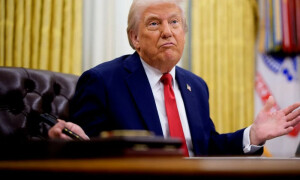NEW YORK: The dollar was little changed on Monday, a day before the Federal Reserve was due to begin a two-day policy meeting, while the euro was boosted by unexpectedly high inflation data before the European Central Bank meets on Thursday.
The US central bank is widely expected to hike interest rates by an additional 25 basis points this week, and investors will be watching for any new indications on how many more rate increases are likely.
Fed Chair Jerome Powell is in a “difficult position” because “they’re going to raise rates 25 basis points and yet he’s going to have to argue against the easing of financial conditions,” said Marc Chandler, chief market strategist at Bannockburn Global Forex in New York.
Fed funds futures traders are pricing for the Fed’s benchmark rate to peak at 4.93% in June, up from 4.33% now, and then for the central bank to cut it to 4.52% by December. This contrasts with comments from Fed officials, who have said that they will need to keep rates in restrictive territory for a period of time in order to bring down inflation.
The dollar index has weakened to 101.88 from a 20-year high of 114.78 on Sept. 28 as investors price in the likelihood that the Fed is nearing the end of its tightening cycle. But it has been largely rangebound for the past few weeks as it hits technical support against major currencies including the euro.
The question now is “does the dollar bounce or is this a nesting pattern before the next leg down,” Chandler said. The euro rose 0.25% to $1.0894 after Spain’s consumer prices rose 5.8% on a year-on-year basis in January, the first increase in six months.
“Today’s data will underline expectations for a 50-basis-point hike from the ECB on Thursday and also signal that rates will be moved further up,” said Niels Christensen, chief analyst at Nordea.
The dollar dipped 0.35% against the Japanese yen.
A panel of academics and business executives on Monday urged the Bank of Japan (BOJ) to make its 2% inflation target a long-term goal instead of one that must be met as soon as possible, in light of the rising cost of prolonged monetary easing.






















Comments
Comments are closed.